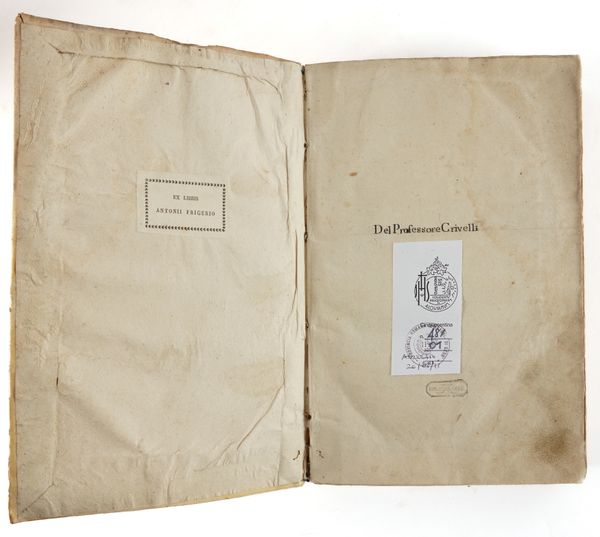EUCLID (fl. 300 BC) & Christopher CLAVIUS (1538-1612). Euclidis elementorum libri XV, Cologne, 1591, 2 volumes bound in one, folio, 2 titles within elaborate woodcut borders, woodcut diagrams (some browning and staining), contemporary limp vellum.
| Estimate: | £400 - £600 |
| Hammer price: | £380 |
EUCLID (fl. 300 BC) & Christopher CLAVIUS (1538-1612). Euclidis elementorum libri XV. [Second volume: Euclidis posteriores libri IX] Accessit XVI. de Solidorum regularium cuius libet intra quodlibet comparatione. Omnes perspicius demonstrationibus, accuratisque scholiis illustrati, ac multarum rerum accessione locupletati: nunc tertio editi, summaq, diligentia recogniti, atque emendati. Cologne: "Expensis Joh. Baptistae Ciotti," 1591. 2 volumes bound in one, folio (326 x 210mm). Two title pages within elaborate woodcut baroque borders incorporating the figures of Euclid and Archimedes, woodcut diagrams, tables, initials and ornaments (waterstaining throughout, including to both titles, with variable, and sometimes quite heavy, browning and other staining, a few leaves heavily browned, some wormholes and wormtracks mainly towards the end, occasionally affecting letters). Contemporary full limp vellum, title in old manuscript on the spine (heavy stain to lower cover, some other staining). Provenance: Professor Crivelli (his name inscribed on the front free endpaper and with his signature on the first title); Antonio Frigerio (ex-libris sticker); later library shelf-mark label at foot of spine; modern (cancelled) institutional library label on front free endpaper); later illegible stamps on front free endpaper and title. The first edition of this work was published in Rome in 1574. Known as 'The Euclid of the 16th-Century', Clavius was a German Jesuit mathematician and astronomer who was instrumental in the Vatican's adoption of the Gregorian calendar, a pioneer of the use of the decimal point, and, in his lifetime, the most highly respected astronomer in Europe. Despite the fact that, for most of his life, he was a proponent, albeit a conflicted one, of the geocentric model of the solar system, he was hugely influential as a writer and teacher and was much admired by Galileo, with whom he maintained a long correspondence. One of the largest crater formations on the moon is named after him. Adams E-988; Brunet II, 1089; Graesse II, 512; Poggendorff I, 455; Thomas-Stanford 23.





